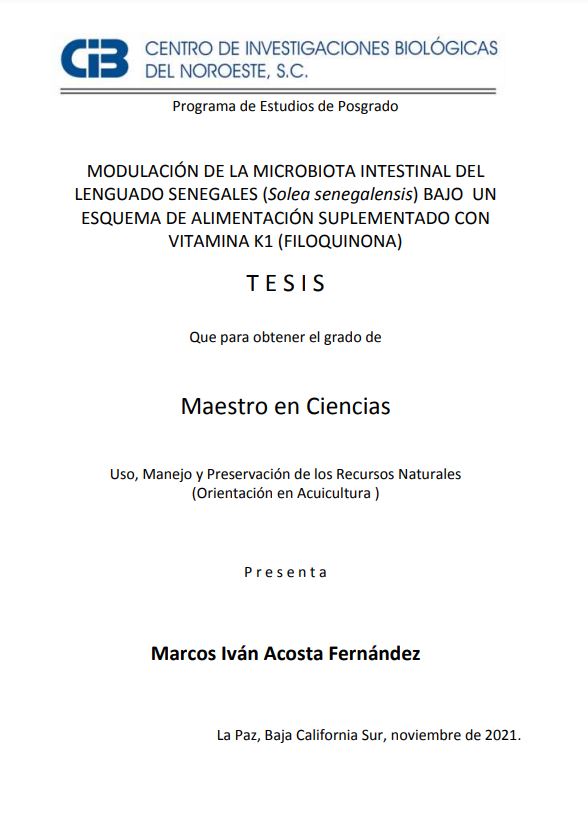| dc.contributor.advisor | Tovar Ramírez, Dariel | |
| dc.contributor.advisor | Quiroz Guzmán, Eduardo | |
| dc.contributor.author | Acosta Fernández, Marcos Iván | |
| dc.date.issued | 2021 | |
| dc.identifier | https://cibnor.repositorioinstitucional.mx/jspui/handle/1001/2514 | |
| dc.identifier.uri | http://dspace.cibnor.mx:8080/handle/123456789/3102 | |
| dc.description.abstract | "La vitamina K es una molécula liposoluble que habitualmente se encuentra en plantas y organismos fotosintéticos en forma de filoquinona (VK1). Hasta ahora, se ha estudiado el efecto de la VK1 sobre procesos biológicos relacionados con el rendimiento larvario, metabolismo óseo y gametogénesis en el lenguado senegalés (Solea senegalensis). Sin embargo, el rol de esta vitamina en la microbiota intestinal aún no ha sido explorado, lo que puede ampliar la perspectiva de su efecto en peces. En el presente trabajo se caracterizaron las comunidades bacterianas del lenguado senegalés bajo un esquema de alimentación suplementado con filoquinona. Un total de 46 peces juveniles con un peso corporal húmedo medio de 48,3 g fueron alimentados con dos dietas experimentales: alimento comercial sin suplementación de VK1 (CT) y alimento comercial suplementado con 1250 mg kg-1 de VK1 (VK) durante 30 días, además se tomaron muestras de peces al inicio del bioensayo (T0) para comparar los cambios al final del mismo. Se utilizó la secuenciación de amplicones de la región V4 del gen ARNr 16S para estudiar el perfil de las comunidades bacterianas con la plataforma MiSeq, Illumina. Las secuencias fueron procesadas con el software Mothur, obteniendo un total de 278,367 lecturas clasificadas taxonómicamente. Se identificaron 35,705 unidades taxonómicas operativas (OTUs) que fueron asignadas de manera dominante al phylum Proteobacteria. Las estimaciones de diversidad alfa (Chao y Shannon) fueron superiores en CT en comparación con T0 y VK (p <0.05). El análisis de la diversidad beta no mostró diferencias significativas entre el grupo VK y los grupos T0 y CT (p >0.05). Sin embargo, una exploración con el análisis de componentes principales (PCA) reveló una separación más clara entre CT y VK, donde se identificaron los géneros que explican una mayor diferencia entre estos dos grupos. En general, las muestras de VK mostraron una tendencia a la disminución de la abundancia en los patógenos oportunistas Vibrio y Arcobacter, así como Pseudoalteromonas y miembros de la familia Rhodobacterace que particularmente se han asociado al deterioro del estatus de salud de organismos acuáticos..." | es |
| dc.format | pdf | es |
| dc.language.iso | spa | es |
| dc.publisher | Centro de Investigaciones Biológicas del Noroeste, S.C. | es |
| dc.rights | Acceso abierto | es |
| dc.subject | Solea senegalensis, microbiota intestinal, vitamina K | es |
| dc.subject | Solea senegalensis, intestinal microbiota, vitamin K | es |
| dc.subject.classification | INMUNOLOGÍA | es |
| dc.title | MODULACIÓN DE LA MICROBIOTA INTESTINAL DEL LENGUADO SENEGALÉS (Solea senegalensis) BAJO UN ESQUEMA DE ALIMENTACIÓN SUPLEMENTADO CON VITAMINA K1 (FILOQUINONA) | es |
| dc.type | masterThesis | es |
| dc.dirtesis.grado | Maestría en Ciencias en el Uso, Manejo y Preservación de los Recursos Naturales | es |
| dc.dirtesis.disciplina | Acuicultura | es |
| dc.dirtesis.universidad | Centro de Investigaciones Biológicas del Noroeste, S.C. | es |
| dc.dirtesis.facultad | Posgrado en Recursos Naturales | es |
| dc.description.abstracten | "Vitamin K is a fat-soluble molecule commonly found in plants and photosynthetic organisms in the form of phylloquinone (VK1). The effect of VK1 on biological processes related to larval performance, bone metabolism and gametogenesis has been studied in Senegalese sole (Solea senegalensis). However, the role of this vitamin in the intestinal microbiota has not been explored yet, which may broaden the perspective of its effect in fish. In the present work, the bacterial communities of Senegalese sole were characterized under a feeding scheme supplemented with phylloquinone. A total of 46 juvenile fish with a mean wet body weight of 48.3 g were fed two experimental diets: commercial feed without VK1 supplementation (CT) and commercial feed supplemented with 1250 mg kg-1 VK1 (VK) for 30 days. Fish were also sampled at the beginning of the bioassay (T0) to compare the changes along the trial. Sequencing of amplicons from the V4 region of the 16S rRNA gene was used to study the bacterial community profile with the MiSeq platform, Illumina. The sequences were processed with Mothur software, obtaining a total of 278,367 taxonomically classified reads. A total of 35,705 operational taxonomic units (OTUs) were identified and assigned dominantly to the phylum Proteobacteria. Alpha diversity estimates (Chao and Shannon) were higher in CT compared to T0 and VK (p <0.05). Beta diversity analysis showed no significant differences between VK and T0 and CT groups (p >0.05). However, an exploration of the data with a principal component analysis (PCA) revealed a clearer separation between CT and VK, where genera explaining a greater difference between these two groups were identified. Overall, the VK samples showed a trend of decreasing abundance in the opportunistic pathogens Vibrio and Arcobacter, as well as Pseudoalteromonas and members of the Rhodobacterace family that have been associated with deteriorating health status of aquatic organisms. By considering a higher alpha diversity in CT, it is suggested that phylloquinone could participate in the host immune response by having a regulatory effect on the proliferation of potential pathogens, while the higher CT diversity could be associated with an imbalance of the sole gut microbiota by such bacterial groups. The results obtained contribute to the understanding of the effect of micronutrients such as vitamin K on the intestinal microbiota of sole with potential projection to other teleost fish." | es |

